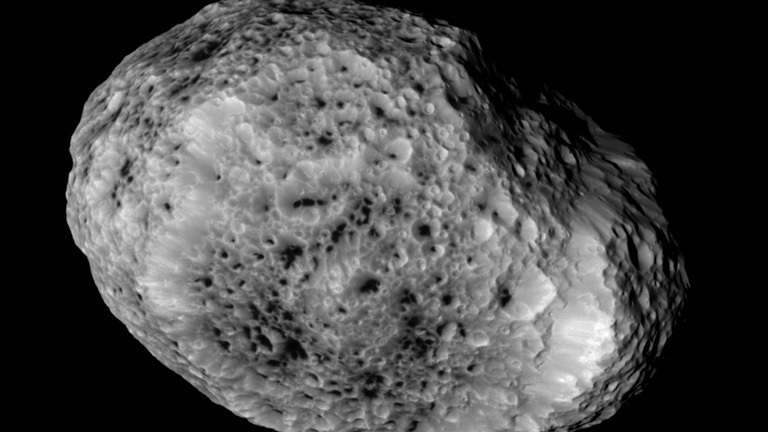News | December 31, 2014
2015 Saturn Tour Highlights

Cassini imaging scientists processed this view of Saturn's moon Hyperion, taken during a close flyby on May 31, 2015. This flyby marks the mission's final close approach to Saturn's largest irregularly shaped moon.
Jan. 11
Titan flyby (970 km or 603 miles) – T108: RADAR will obtain altimetry on Punga Mare, providing a depth and/or composition constraint on all three seas on Titan. RADAR will capture a SAR (synthetic aperture radar) observation of the Ligiea Mare “ magic island”, a highly dynamic feature first seen during a July 2013 flyby. The RADAR observation of the “magic island” during the August 2014 T104 flyby showed that the feature’s appearance had changed dramatically.
Feb. 12
Titan flyby (1,200 km or 746 miles) – T109: The VIMS (visible and infrared mapping spectrometer)will use a ‘push-broom’ mode to take a high-resolution swath across the polar cap north of 60 degrees latitude. This path will cross Punga Mare and possibly Kivu Lacus to investigate compositional differences in the faculae and the dunes. VIMS will also image the south pole to view the evolution of the south polar vortex and perhaps capture specular reflection on the northeastern tip of Kraken Mare and across the strait that links Kraken and Ligeia. CIRS (the composite infrared spectrometer ) will perform limb sounding in the far-infrared at 50N to extend spatial coverage of gas and aerosol vertical distributions. ISS will image Titan's surface and atmosphere over the equatorial sub-Saturnian hemisphere, including northern Tsegihi and eastern Aztlan.
March 16
Titan flyby (2,275 km or 1,414 miles)– T110: Closest approach science consists of a unique VIMS (visible and infrared mapping spectrometer) regional map at high resolution of the north polar lakes. A high-resolution (less than 5 km per pixel) mosaic of part of the north polar area will be acquired to look for changes with summer solstice. Additional gravity data using the low gain antenna (LGA) will be obtained on T110 will contribute to our understanding of Titan’s interior structure.
May 7
Titan flyby (2,722 km or 1,691 miles)– T111: VIMS (visible and infrared mapping spectrometer) will construct a mosaic of Xanadu at 10 km resolution, taking advantage of the low phase angle (< 30 degrees). High resolution images of Mnerva will be acquired at closest approach. The composite infrared spectrometer (CIRS) will conduct limb sounding in the far-IR at 60 degrees south to provide insight into the formation of the southern winter polar vortex as well as obtaining information in the thermal structure and composition of the stratosphere. ISS will obtain images of Titan's surface and atmosphere, including eastern Shangri-La and western Xanadu.
July 7
Titan flyby (10,953 km or 6,806 miles) – T112:The composite infrared spectrometer (CIRS) will perform back-to-back limb sounding observations at closest approach, reaching high northern and southern latitudes to contrast the temperatures and gas abundances at the summer and winter poles. The highest northern latitude of the Cassini Solstice Mission for far-IR limb-sounding is reached, at 80N. VIMS (visible and infrared mapping spectrometer) will acquire a mosaic of the sub- Saturn tropical zone that includes the dune fields of Fensal and Aztlan and the Qilvira plateau. VIMS will also observe the evolution of the South Polar vortex and will look for the formation of clouds at northern mid-latitudes. On the outbound, VIMS will take images of the North Polar area with the seas illuminated.
Sept. 28
Titan flyby (1,036 km or 644 miles) – T113: This is one of only two dawn side passes (T5 and T113) in Saturn’s magnetosphere on which INMS (ion and neutral mass spectrometer) will sample Titan’s neutral atmosphere and ionosphere. On inbound at high altitudes, INMS will observe ions outflowing from Titan. At the lower altitudes around closest approach, INMS will be riding along with RADAR measuring ions and neutrals while RADAR obtains SAR of Eastern Xanadu at closest approach.
Nov. 13
Titan flyby (11,920 km or 7,407 miles) – T114: Near closest-approach, ISS will acquire a medium-to-high-resolution mosaic of Titan's leading hemisphere over Xanadu. Other observations on this flyby include VIMS (visible and infrared mapping spectrometer) monitoring of the formation and evolution of clouds at high latitudes and evolution of south polar vortex. VIMS will map the North pole area at high emission angle and will monitor the evolution of the lakes and seas. CIRS (the composite infrared spectrometer) will perform very high latitude limb sounding over the south pole, monitoring the temperatures and composition in the south polar vortex as it continues to develop in southern fall. The latitudes viewed on T114 are the most southerly latitudes possible for far-infrared limb measurements during the Cassini Solstice Mission.
